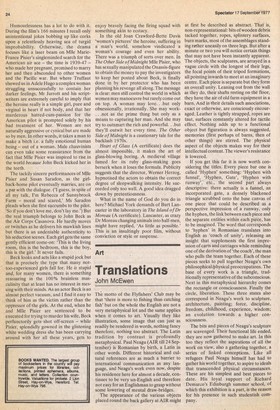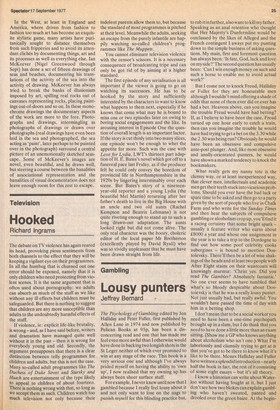Art
Translations
John McEwen
The motto of the Flyfishers' Club may be that 'there is more to fishing than catching fish' but on the whole the English are not a very metaphysical lot and the same applies when it comes to art. Visually they like illustration, some image that can just as readily be rendered in words, nothing fancy therefore, nothing too abstract. The Latin tradition by contrast is profoundly metaphysical. Paul Neagu (AIR till 24 September) is Romanian by birth, a Latin in other words. Different historical and cultural references are as much a barrier to international communication as any language, and Neagu's work even now, despite his residence here for almost a decade, continues to be very un-English and therefore not easy for an Englishman to grasp without some lowering of mental draw-bridges.
The appearance of the various objects placed round the back gallery at AIR might at first be described as abstract. That is, non-representational: bits of wooden debris tacked together, ropes, splintery surfaces, burn marks, most of the assemblages standing rather uneasily on three legs. But after a minute or two you will notice certain things that may not have been instantly apparent. The objects, the sculptures, are arrayed in a vague circle with the longest of their legs, the focal points of their tripod formations, all pointing inwards to meet at an imaginary centre. Each piece is separate but they form an overall unity. Leaning out from the wall as they do, their shafts resting on the floor, they have the air of old farm equipment in a barn. And in their details such associations, exact or otherwise, are consciously encouraged. Leather is tightly strapped, ropes are taut, surfaces constantly altered for tactile effect. Nothing adds up to a functional object but figuration is always suggested, memories (first perhaps of barns, then of other things) are stirred. The physical aspect of the objects makes way for their intellectual content. The viewer's resistance is lowered.
If you get this far it is now worth considering the titles. Every piece bar one is called 'Hyphen' something: 'Hyphen with funnel', 'Hyphen, Gate', 'Hyphen with runway', etc., the second part always descriptive: there actually is a funnel, an incorporated gate, a densely blackened triangle scrubbed onto the base canvas of one piece that could be described as a perspective impression of a runway, only the hyphen, the link between each piece and the separate entities within each piece, has to be imagined. The word that corresponds to 'hyphen' in Rotnanian translates into English as 'coach of unity', releasing an insight that supplements the first impression of carts and carriages while reminding one of the derivation of 'the coach', the man who pulls the team together. Each of these pieces seeks to pull together Neagu's own philosophical/physical preoccupations. The base of every work is a triangle, traditionally representative of the subconscious. Next in this metaphysical hierarchy comes the rectangle or consciousness. Finally the circle, liberation. These three states also correspond in Neagu's work to sculpture, architecture, painting; force, discipline, freedom, childhood, experience, wisdom; an evolution towards a higher consciousness.
The bits and pieces of Neagu's sculpture are scavenged. Their functional life ended, they are now gathered to make art. In this too they reflect the aspirations of all the work on view, also a gathering together, a series of linked conceptions. Like all refugees Paul Neagu himself has had to gather his world together, to aspire to ideals that transcended physical circumstances. These are his simplest and best pieces to date. His loyal support of Richard Demarco's Edinburgh summer school, of which this exhibition is a part, is the reason for his presence in such studentish company. In the West, at least in England and America, where driven from fashion to fashion too much art has become an exquisite stylistic game, many artists have puritanically sought to distance themselves from such fripperies and to avoid its attendant clichés by documenting things, art and its processes as well as everything else. Ian McKeever (Nigel Greenwood through Sept) has done a set of fifteen drawings of seas and beaches, documenting his translations of the activity of the sea into the activity of drawing. McKeever has always tried to break the banks of illusionism imposed by art, spilling real rocks out of canvases representing rocks, placing paintings out-of-doors and so on. In these monochrome drawings the documentary aspects of the work are more to the fore. Photographs and drawings, intermingling as photographs of drawings or drawn over photographs (real drawings have even been laid in the sea and photographed, the sea acting as 'paint', later perhaps to be painted over in the photograph) surround a central picture of an unemotionally sketched seascape. Some of McKeever's images are novel, even beautiful, and he draws well, but steering a course between the banalities of associational representation and the banalities of visual documentation does not leave enough room for this zest to escape.































 Previous page
Previous page